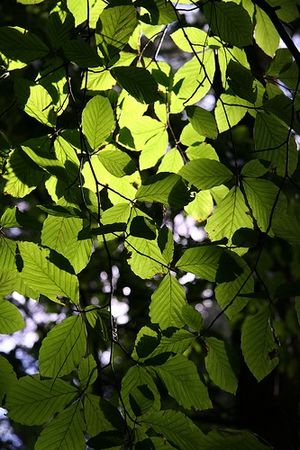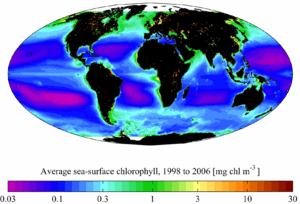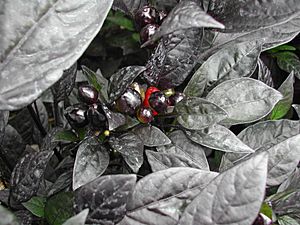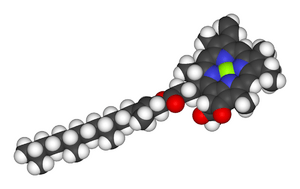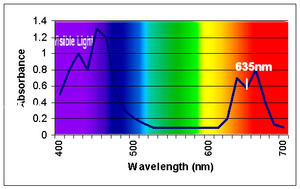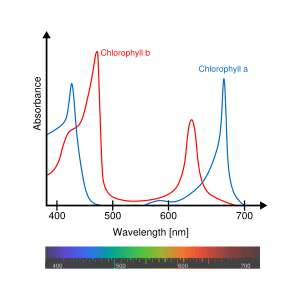Chlorophyll facts for kids
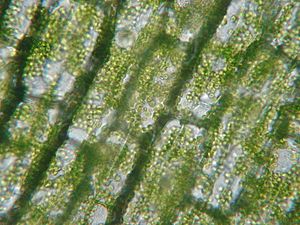
Chlorophyll is a green pigment found in plants and algae that helps them make food using sunlight. Energy from the light is used in photosynthesis to make glucose. This contains lots of stored energy which the plant needs to release. It does this through respiration. This energy is then used when the plant grows or repairs damage.
Chlorophyll also makes the stem and leaf of the plant green.
Contents
What is Chlorophyll?
Imagine you're a plant, and you need to eat to grow big and strong. But plants can't go to the grocery store! Instead, they have a special ingredient called chlorophyll that helps them make their own food using sunlight.
Chlorophyll is like a plant's personal solar panel. It's a green pigment, which means it's a substance that gives plants their green color. You can find chlorophyll in the green parts of plants, like the leaves and stems, and also in tiny organisms called algae and cyanobacteria.
The word "chlorophyll" comes from two Greek words: "khloros," which means "pale green," and "phyllon," which means "leaf." So, chlorophyll is basically the "green stuff in leaves"!
History
People have been studying chlorophyll for a long time! Here's a quick trip through its history:
- 1817: Two French scientists, Joseph Bienaimé Caventou and Pierre Joseph Pelletier, were the first to isolate and name chlorophyll.
- 1906: Scientists discovered that chlorophyll contains magnesium, which is a type of mineral. This was the first time anyone had found magnesium in living tissue!
- 1905-1915: A German chemist named Richard Willstätter spent many years studying chlorophyll and figuring out its structure.
- 1940: Another scientist, Hans Fischer, figured out the general structure of chlorophyll a, which is one of the main types of chlorophyll.
- 1960: Robert Burns Woodward published a complete synthesis of the molecule.
- 1967: Ian Fleming completed the last remaining stereochemical elucidation.
- 1990: Woodward and co-authors published an updated synthesis.
- 2010: Scientists discovered a new type of chlorophyll called chlorophyll f in cyanobacteria and other tiny organisms.
Photosynthesis
Chlorophyll's main job is to help plants make food through a process called photosynthesis. "Photo" means light, and "synthesis" means putting things together. So, photosynthesis is like using light to put things together!
Here's how it works:
1. Capturing Sunlight: Chlorophyll molecules are arranged in special structures called photosystems, which are found in the chloroplasts inside plant cells. These photosystems are like tiny antennas that capture sunlight.
2. Transferring Energy: Once chlorophyll captures sunlight, it transfers the energy to a special pair of chlorophyll molecules in the reaction center of the photosystem.
3. Charge Separation: The special chlorophyll pair uses the energy to separate charges, creating unbound protons (H+) and electrons (e-). These particles are then used to power the rest of the photosynthesis process.
There are two main types of photosystems: photosystem I and photosystem II. They each have their own reaction centers, called P700 and P680, respectively. These names come from the wavelength of light that they absorb best.
Photosynthesis is super important because it's how plants make their own food (sugars) and release oxygen into the air. Oxygen is what we breathe, so we can thank chlorophyll for helping us stay alive!
Chemical Structure
Chlorophyll is a complex molecule with a special structure that allows it to absorb light. All chlorophyll molecules are based on a structure called chlorin, which is similar to a molecule called porphyrin (found in hemoglobin, the stuff that makes our blood red).
Most chlorophyll molecules have a magnesium atom in the center, which is important for their function. They also have various side chains attached to the chlorin ring, including a long chain called a phytyl chain.
There are several different types of chlorophyll, including:
- Chlorophyll a: The most common type of chlorophyll in plants.
- Chlorophyll b: Another type of chlorophyll that helps plants absorb a wider range of light.
- Chlorophyll e: A pigment that has been extracted from algae.
- 8-vinyl Chl a and b: Used by Prochlorococcus, a cyanobacterium.
The different types of chlorophyll have slightly different structures, which means they absorb light at slightly different wavelengths. This helps plants capture as much sunlight as possible.
Measuring Chlorophyll Content
Scientists can measure the amount of chlorophyll in a plant by extracting it with organic solvents. They can also separate chlorophyll a and chlorophyll b to see how much of each type is present.
One way to measure chlorophyll is by using a spectrophotometer, which is a machine that measures how much light a substance absorbs. Chlorophyll a absorbs light best at wavelengths of around 430 nm and 662 nm, while chlorophyll b absorbs light best at wavelengths of around 453 nm and 642 nm.
Scientists can also use fluorescence to measure chlorophyll content. Chlorophyll a fluoresces (emits light) at a wavelength of 673 nm.
There are also special sensors that can measure chlorophyll content by measuring the light transmittance through plant leaves. These sensors allow scientists to make real-time and non-destructive measurements of chlorophyll.
How Chlorophyll is Made: Biosynthesis
Chlorophyll is made through a complex process called biosynthesis. In plants, chlorophyll is made from a substance called glutamate.
The biosynthesis of chlorophyll involves many steps and requires several different enzymes. One of the key enzymes is chlorophyll synthase, which adds a phytyl chain to chlorophyllide a to make chlorophyll a.
The later steps in the biosynthesis pathway are light-dependent in some plants, which means they only happen when there is light. Plants grown in the dark will be pale because they can't make chlorophyll.
Chlorophyll and Senescence
Senescence is the process of aging in plants. During senescence, chlorophyll is broken down, which is why leaves change color in the fall.
The enzyme chlorophyllase breaks down chlorophyll by removing the phytyl sidechain. The chlorophyllide a can be converted to chlorophyllide b and the latter can be re-esterified to chlorophyll b, these processes allow cycling between chlorophylls a and b. Moreover, chlorophyll b can be directly reduced (via 71-hydroxychlorophyll a) back to chlorophyll a, completing the cycle.
The breakdown products of chlorophyll are called nonfluorescent chlorophyll catabolites (NCC's). These compounds are colorless and give fruits and deciduous plants their characteristic autumn colors.
Where Chlorophyll is Found: Distribution
Chlorophyll is found in plants, algae, and cyanobacteria all over the world. NASA has created maps showing the amount of chlorophyll in the ocean. These maps show that the highest concentrations of chlorophyll are found in cold polar waters and in areas where ocean currents bring cold water to the surface.
The cold water itself doesn't stimulate the phytoplankton. Instead, the cool temperatures are often a sign that the water has welled up to the surface from deeper in the ocean, carrying nutrients that have built up over time. In polar waters, nutrients accumulate in surface waters during the dark winter months when plants cannot grow. When sunlight returns in the spring and summer, the plants flourish in high concentrations.
How Chlorophyll is Used
Chlorophyll has several different uses:
- Food Coloring: Chlorophyll is used as a food coloring to give foods and beverages a green color. It has the E number E140.
- Marketing: In the past, chlorophyll was used in marketing to promote products like toothpaste and soap. However, these claims were later found to be unsubstantiated.
Fun Facts About Chlorophyll
- Chlorophyll absorbs light most strongly in the blue and red portions of the electromagnetic spectrum.
- Chlorophyll is a poor absorber of green light, which is why plants appear green.
- Chlorophyll is essential for life on Earth because it's how plants make their own food and release oxygen into the atmosphere.
Related pages
Images for kids
See also
 In Spanish: Clorofila para niños
In Spanish: Clorofila para niños


